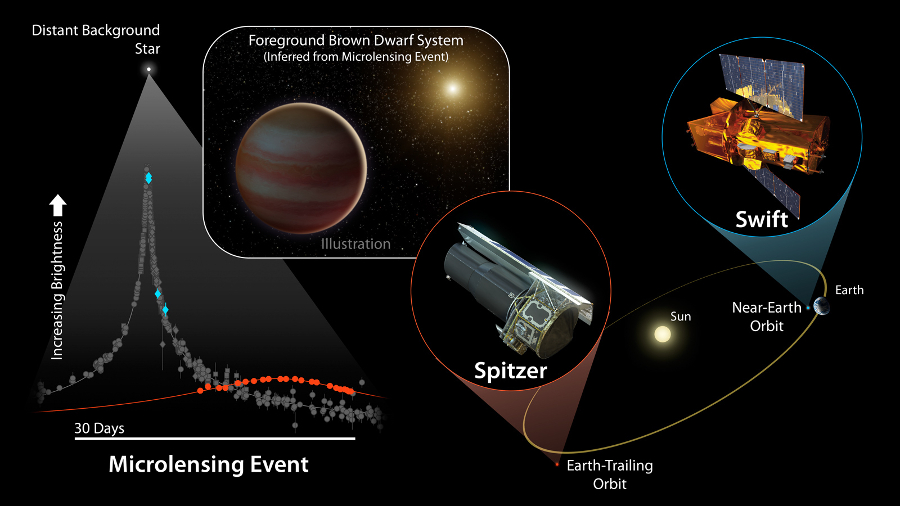
 Credit: NASA/JPL-Caltech
Credit: NASA/JPL-Caltech
Dwarf Microlens
Mass warps spacetime, as Einstein described. The observable effect of this warping is the bending of the path of light rays around massive bodies. This bending of light by mass produces a natural lens, where the light of background star is magnified and brightened by the presence of a foreground object. If two objects orbit a common center of mass, the brightness of the background object will temporarily increase due to the lensing effect when the foreground star moves between the background object and the observer. Because the bending of light depends on mass, the light bending produced by "low mass" objects like stars and planets is small, and astronomers refer to this effect in stellar systems as "microlensing". Sudden brightness changes of stars caused by microlensing can signal to astronomers that a star has an otherwise unseen low-mass companion (perhaps a planet). The image above summarizes a campaign of observations of a rather non-descript star obtained by OGLE, the Optical Gravitational Lensing Experiment (a long term project to study microlensing phenomena using ground-based telescopes), and from space using the optical telescope on the Swift space telescope and the Spitzer Space Telescope. The plot on the left shows the increase in brightness of this star seen by OGLE (grey circles), Swift (blue diamonds), and Spitzer (red circles) caused by a "microlensing event". Spitzer's large distance from earth (as shown in the schematic on the right) in its Earth-trailing orbit gives it a different view of the microlensing event compared to the OGLE and Swift observatories (which observe the event from near the earth) and produce the differences seen in the Spitzer brightness variations compared to the Swift and OGLE observations. By analyzing the brightness variations and the differences in the brightness variation seen by OGLE, Swift and Spitzer, astronomers were able to determine the mass of the foreground object that produces the gravitational lensing. These observations showed that the lensing object is a rare "brown dwarf" (as shown in the central illustration), a failed star that does not have enough mass to ignite its central thermonuclear fires.
Published: December 12, 2016
<
HEA Dictionary ● Archive
● Search HEAPOW
● Other Languages
● HEAPOW on Facebook
● Download all Images
● Education ● HEAD
>

Each week the HEASARC
brings you new, exciting and beautiful images from X-ray and Gamma ray
astronomy. Check back each week and be sure to check out the HEAPOW archive!
Last modified Tuesday, 27-Feb-2024 10:10:10 EST


